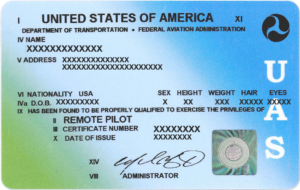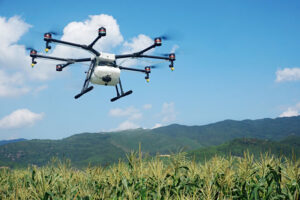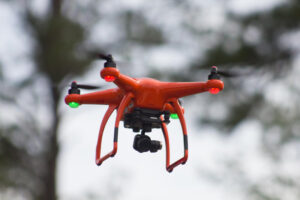 The small Unmanned Aircraft Systems (sUAS) rule, also known as Part 107, was designed to minimize risks and establish the certification requirements for the thousands of pilots expected to fill the role of Remote Pilot in Command (PIC). This rule streamlined the process of operating drones for routine commercial flights. More than 69,000 remote pilot certificates have already been issued by the FAA since August 29, 2016.
The small Unmanned Aircraft Systems (sUAS) rule, also known as Part 107, was designed to minimize risks and establish the certification requirements for the thousands of pilots expected to fill the role of Remote Pilot in Command (PIC). This rule streamlined the process of operating drones for routine commercial flights. More than 69,000 remote pilot certificates have already been issued by the FAA since August 29, 2016.
Prior to Part 107, commercial sUAS flights operated under a Section 333 exemption, which generally required operators to become a certificated pilot. Many remote pilots spent thousands of dollars to become a pilot simply to fulfill the Section 333 exemption requirements. Part 107 made this unnecessary by substantially reducing the requirements for remote pilots.
14 CFR 107 Subpart C includes the certification requirements. The remote PIC must be at least 16 years old and have a remote pilot certificate with a small UAS rating or be directly supervised by someone with such a certificate.
Manned aircraft pilots enjoy a streamlined certification process, while those without any aviation experience must pass a knowledge test. The subject matters covered are all relevant to understanding safe operations and airspace integration.
Does Part 107 apply to you?
According to § 107.1 (a) “Except as provided in paragraph (b) of this section, this part applies to the registration, airman certification, and operation of civil small unmanned aircraft systems within the United States.” The exception listed in § 107.1 (b)(2), applies to “any aircraft subject to the provisions of Part 101.” Part 101, Subpart E includes the regulations for recreational and hobby operators of certain model aircraft.
 Other than the sUAS operations that are strictly for hobby or recreation, commercial drone flights are regulated by Part 107. These commercial rules, under Part 107, restrict flights to within line of sight, during daylight hours, with aircraft weighing under 55 pounds, traveling at speeds less than 100 MPH, and remaining below 400 feet. Considering the broad range of UAVs, three-pound quadcopters are one thing, but a 50-plus pound fixed wing aircraft purpose-built for mapping or surveillance has entirely different characteristics and risks, yet both are covered by Part 107.
Other than the sUAS operations that are strictly for hobby or recreation, commercial drone flights are regulated by Part 107. These commercial rules, under Part 107, restrict flights to within line of sight, during daylight hours, with aircraft weighing under 55 pounds, traveling at speeds less than 100 MPH, and remaining below 400 feet. Considering the broad range of UAVs, three-pound quadcopters are one thing, but a 50-plus pound fixed wing aircraft purpose-built for mapping or surveillance has entirely different characteristics and risks, yet both are covered by Part 107.
If you are not sure whether you should be flying under the hobby/recreation rules or the commercial Part 107 rules, then you should probably fly in accordance with Part 107. The remote pilot certificate is easy to earn with online training and thorough preparation. A summary of the regulations, along with training options can be found at www.gleimaviation.com/drones.
What rules apply to drones for recreation and hobbyists?
If you only fly models and drones for fun, then you can direct your attention to the Special Rule for Model Aircraft in 14 CFR 101 Subpart E. There are at least six regulations that recreational sUAS pilots should comply with.
- § 101.41 (a), Non-commercial use: “The aircraft is flown strictly for hobby or recreational use.” You don’t have to get paid for your sUAS operations to be considered commercial. For example, if you’re capturing images in hopes of selling them later, go back to Part 107; this is no longer a recreational flight.
- § 101.41 (b), Safety guidelines: “The aircraft is operated in accordance with a community-based set of safety guidelines and within the programming of a nationwide community-based organization.” This means your recreational flights must be flown according to the provisions of organizations such as the Academy of Model Aeronautics (AMA) and the National Model Aircraft Safety Code. Notable guidelines include the requirements to remain at least 25 feet away from other individuals and the prohibition on touching an outdoor model aircraft in flight. In other words, don’t try to catch a sUAS by hand in flight.
- § 101.41 (c), Weight limits: “Aircraft are limited to not more than 55 pounds unless otherwise certified through a . . . community-based organization.” Refer to the AMA “Large Model Airplane program.”
- § 101.41 (d), Right-of-way: “The aircraft is operated in a manner that does not interfere with and gives way to any manned aircraft.” This should be common sense, but remember that manned aircraft are far less maneuverable, and the pilots of manned aircraft are less likely to see an sUAS. Therefore, manned aircraft always have the right-of-way.
- § 101.41 (e), Operations near airports: “When flown within 5 miles of an airport . . . provide the airport . . . with prior notice of the operation.” While this quote may read to a non-certificated pilot that the airport merely requests prior notice, this required notice is technically a request by the remote pilot to operate within 5 miles of the airport. The airport operator or control tower can disapprove your intended operations, effectively making the “notice” a request for permission.
- § 101.43, Airspace safety: “No person may operate model aircraft so as to endanger the safety of the national airspace system.” This can be a catch-all for any type of operation that the FAA deems to violate any other provisions.
Do I have to register my drone?
As a final requirement, the FAA requires all owners of sUAS weighing between 0.55 and 55 pounds to register online before taking to the skies. Both hobbyists and Part 107 pilots must register their drones. A moratorium was temporarily placed on the registration requirement  for hobbyists in 2017; however, the requirement is in effect again. Be wary of services charging high fees to process registrations. You can easily register your drone directly with the FAA at the FAADroneZone website.
for hobbyists in 2017; however, the requirement is in effect again. Be wary of services charging high fees to process registrations. You can easily register your drone directly with the FAA at the FAADroneZone website.
If you are interested in pursuing a career as a professional remote pilot, check out the article Making Money Using Drones In 2018. No matter what type of flying you are doing, make sure you always fly safely and in accordance with all laws and regulations. For more information about becoming a remote pilot, visit the Gleim Aviation Drones webpage or call (800) 874-5346 ext. 471.
About Gleim Aviation
Since 1980, the Gleim Aviation team of pilots, instructors, writers, designers, and programmers has helped aviators pass millions of FAA knowledge and practical tests using the unique Gleim Knowledge Transfer System. Gleim is an environmentally-friendly company headquartered in Gainesville, FL.

